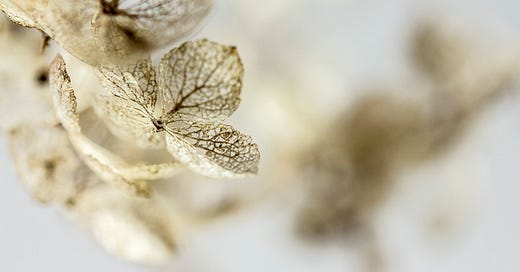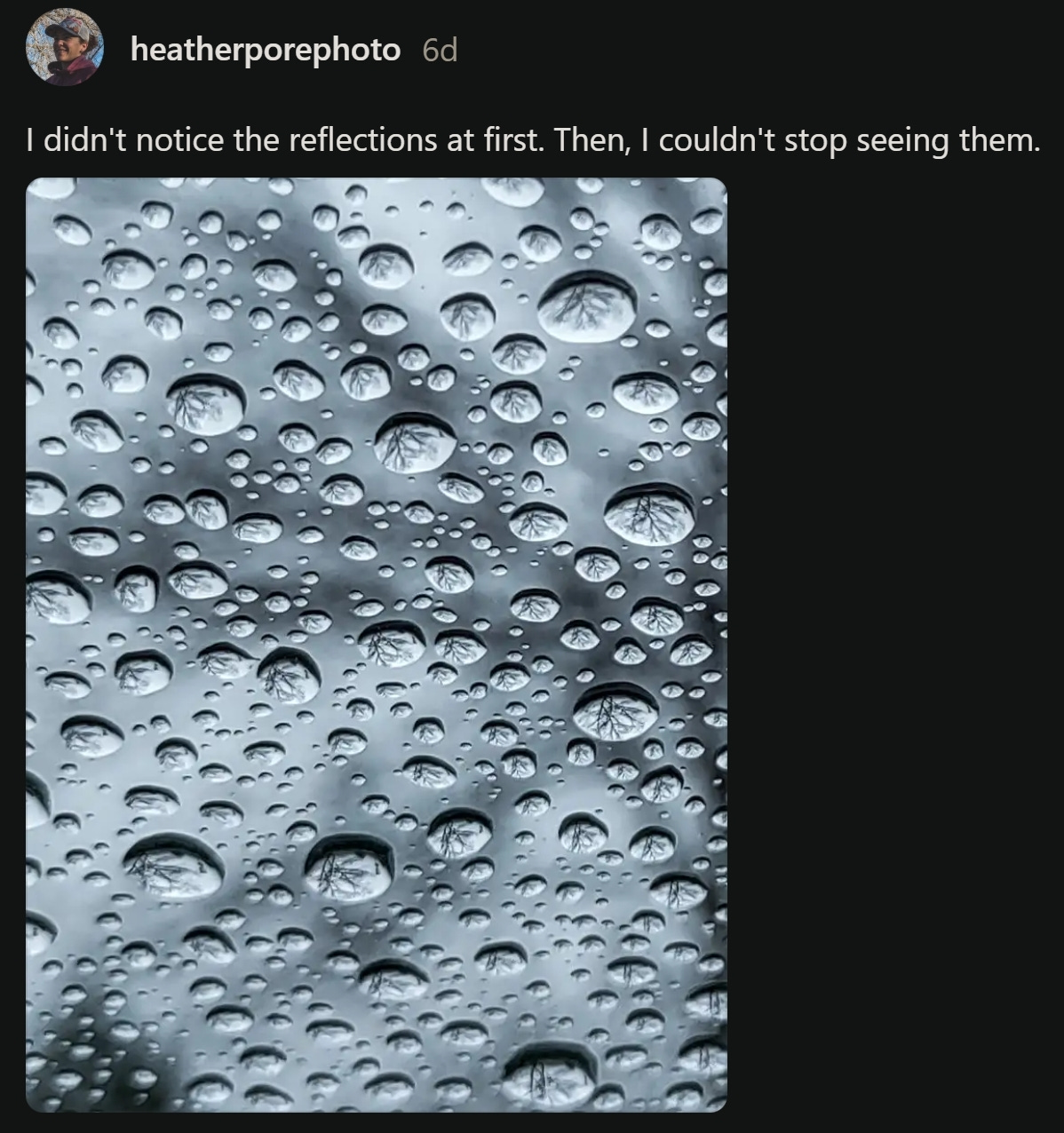Hello, wildling. I’m so glad you’re here.
This may be one of the heaviest posts we share together, but also one of the most necessary.
Because we all grieve. And nature knows how to grieve with us.
The Many Faces of Grief
Grief has many definitions. It isn’t just a reaction to death or endings. It can follow any loss: a friendship, a job, a place, a dream.
The Kübler-Ross Grief Cycle, aka Five Stages of Grief, was developed by Swiss-American psychiatrist Elisabeth Kübler-Ross in 1969. It outlines five common emotional stages people often move through after loss: denial, anger, bargaining, depression, and acceptance.
This model has become a foundation in grief psychology. However, not everyone experiences every stage, and the stages aren't always linear. They’re not steps on a ladder that we climb to move on. They’re waves—sometimes crashing, sometimes still.
Grief touches the body, the mind, and the spirit. When grieving:
🕊 Our nervous systems can flare with stress.
🕊 Our bodies can feel the effects, like sleeplessness or chronic pain.
🕊 Our thoughts can spiral.
🕊 Our hope may dim.
🕊 We may fall into despair.
🕊 We may question our beliefs.
And yet, grief also opens us. It asks us to pause. To feel. To remember.
Grief Happens in Nature, Too
Nature teaches us that grief is not a human invention; it's a universal experience. It lives in the wild, too.
When an elephant dies, its herd lingers. They caress the bones with their trunks. They return to the place of death year after year. Not because they expect a change, but because remembrance matters.
And crows (my beloved kin) hold what researchers call “crow funerals.” When one dies, the others gather, silent and alert. Acknowledging, feeling, and responding as a community.
These small gestures in the natural world remind us: we are not alone in our sorrow. 💔
When Our Grief is for Our World
As we work more intimately with nature, grief can take on a distinct form: eco-grief.
🔎 Eco-grief is the psychological and emotional pain caused by environmental loss: species extinction, forest destruction, glacial melting, climate change, or the slow unraveling of ecosystems we love.
The more time we spend in nature, the deeper our connection becomes. And that connection opens the door to grief, because we begin to notice what’s missing.
Birdsong that never returned in spring.
A favorite forest trail lost to wildfire.
A beach eroded year by year.
Eco-grief is painful, but it's also a sign of empathy. It means we’ve allowed ourselves to love our wild community. And it means we’re awake.
If your grief for the earth becomes heavy, you are not broken. You are becoming. 🌱
If it's too much to carry, please know: eco-grief is a recognized area of psychological care. Therapists now specialize in it. Support exists. This grief is valid, and help is available. Seeking that help is an act of devotion to yourself and the planet.
Growing Through Grief
Last month, I had a heartfelt exchange with the visionary writer Nellie Rose Coffy, whose “love letters" newsletter has long found a home in my inbox.
Nellie is also the author of a powerful essay called This Is How We Heal the World. I recommend it to every wild soul.
In one of her letters, Nellie likened grief to a garden. Her words found me at the right time.
I’d been tangled in big feelings while developing the eco-grief section of the Whispering Wilds core class. The sorrow of so much loss in the natural world overwhelmed me. I cried for days. I knew it was time to pause and process.
Nellie’s metaphor shifted everything. I saw mourning as planting. I grieved, but I still held space for growth. I imagined my tears watering seeds of hope.
And ever since, I’ve tended to my eco-grief like a garden—raw, uncertain, but full of potential.
When I shared this with Nellie, she responded with such warmth, and later wrote a beautiful thread about grieving for our planet. I carry her words with me now, like a packet of seeds in my pocket. 🌱
"This eco-grief is not just sadness.
It’s mourning.
It’s our bodies remembering that we, too, are Earth.
It’s our hearts breaking open at the loss of what once held us." - Nellie Rose Coffy
A Flower I Never Knew
I wear a story of extinction on my skin every day.
A fragrance company called Future Society* creates perfumes from the DNA of extinct flora, scents resurrected through science. My favorite is called Reclaimed Flame, which contains a South African flower that vanished due to wildfires, afforestation, and vineyard expansion.
I never smelled the original flower. I never saw it bloom.
But now, I keep it with me. Atop my pulse points, I cradle its memory, its essence, and its legacy. I wear it as an act of love. A gentle rebellion. A vow.🌼
Grief is sometimes like that, isn’t it?
We carry what we’ve lost.
And in carrying it, we honor it.
*this link contains a referral code for a $10 credit with any purchase you make. If you prefer to browse or shop without the code, use this link instead.
A Journal Practice for Rooted Reflection
One of the most powerful tools in the Whispering Wilds method is something I call Rooted Reflection, or the Journal Tree. It’s a five-part practice of biomimetic journaling inspired by how trees grow and branch.
I created this way to journal for deep self-discovery. It yields topics for future reflection, actionable insights for the present, and moments of brightness even in the darkest times.
While you can write about anything in rooted reflection, today I invite you to reflect on something you're grieving or have grieved. Or something you feel anxious about losing in the future. Let's plant a journal tree together.
Here’s how it works:
🌳 Roots: Begin with a word association or freewriting exercise around a loss you’ve experienced. Write quickly and without judgment, letting the words flow. Don't worry if it's disorganized.
🌳 Trunk: Read your roots and find the core theme. The theme may be present in words you repeated or statements that give you "aha!" moments. Write carefully and thoughtfully about that theme. This is your foundation, and the most structured part of the journal entry. Be detailed. Get it all out.
🌳 Branches: Review your trunk and circle or underline what moves you or gives you pause. Perhaps some things you've written make your heart ache or spark curiosity. Maybe they bring you hope, excitement, or peace. For each one, write a new question and answer it in a short, informal paragraph. Let your insights grow in every direction.
🌳 Blooms: What did you learn as your journal branched? What truths did you uncover? What feelings rose to the surface? These are your blooms, your takeaways. Ideally, your blooms reveal actions you can take to heal, to build strength, and to find balance.
🌳 Seeds: Every entry in rooted reflection ends positively. For each bloom, write down one thing you’re grateful for. Big or small. Gratitude is the soft moss that keeps our roots warm. It's one of the keys to unlocking happiness.
In the not-too-distant future, I'll release a special mini-class on the Journal Tree as part of the Whispering Wilds educational series.
Until then, try this exercise at your own pace, on your own terms. Let your grief grow something new.
Journaling is a powerful tool, but it’s not right for everyone. In-depth analysis of our lives, thoughts, and feelings can cause distress. Consult a mental health professional before journaling.
“In one of those stars I shall be living. In one of them I shall be laughing. And so it will be as if all the stars were laughing, when you look at the sky at night. And when your sorrow is comforted (time soothes all sorrows) you will be content that you have known me. You will always be my friend...I shall not leave you.” - Antoine de Saint-Exupéry, The Little Prince
Carry This With You
If you’ve read this far, thank you for staying with me. This wasn’t a light topic, and it takes bravery to think about loss.💫
Remember...
🌿 Grief is proof that you've loved deeply.
🌿 Grief is wild, and nature can hold it with you.
The wild doesn't rush healing. It simply continues. Weathering storms, sprouting again.
Let it guide you.
Parting Thoughts to Leave Us Lighter
From time to time, I enjoy sharing a glimpse into my life through the experiences I have. I hope something piques your interest!
🎨What I'm Creating: Remember my early podcast episode about raindrops? I was so inspired by this amazing photo taken by Heather Bore, a gifted photographer and born adventurer, that I revisited the exercise and drew more soothing droplets. Can you believe the reflections Heather captured?
🎶 What I'm Listening to: Anticipating Aurora's return to the video game Sky: Children of The Light in June I'm listening...over and over...to her unbelievable a cappella performance of "Through the Eyes of a Child." This song is especially powerful during the world-record-setting virtual concert she performed in Sky a few years ago—and without spoiling anything, I'll just say have tissues on hand if you catch an encore. Now's a great time to check out Sky and learn how to play. It's truly one of the most wholesome games ever created, and it's available for free on PC, console, and mobile devices. I don’t have much time to play, but it’s my go-to when I have idle moments.
📖 What I'm Reading: In a freshly published post for her LinkedIn newsletter, Regenerative leadership expert Dr. Kathy Allen talks about Life-Affirming Nutrients We Need Now. According to Dr. Allen, "the nutrients that help us thrive are emotional, relational, and energetic." When the state of the world makes it hard for us to find nourishment, it's up to us to safeguard our well-being. Dr. Allen shares ideas for sheltering our vital nutrients.
"What keeps our minds and hearts resilient and evolving? Life-affirming nutrients like trust, kindness, connection, safety, learning, curiosity, and purpose." - Dr. Kathy Allen
I'm wishing you abundance and peace, my friend.
Dina
If you enjoy The Whispering Wilds and feel moved to help, tips are always appreciated and keep this space thriving. ✨
Please Note...
The Whispering Wilds method is not a replacement for medical and mental health care. Alternative health and wellness shines when it complements modern medicine, just as I believe modern medicine is at its best when accompanied by a holistic perspective. If you have a heart, lung, or circulatory condition, or suspect you do, or if you have a mental health disorder, or suspect you do, please ask your doctor or therapist before beginning any wellness practice.
Breathwork, meditation, journaling, movement, and other practices in The Whispering Wilds aren't suitable for everyone. The good news is that if your doctor or therapist advises you against a particular practice, the Whispering Wilds method will likely present alternatives to explore. Always ask your medical or mental health professionals first because we are all complex, unique individuals, and no true wellness approach is one-size-fits-all.







